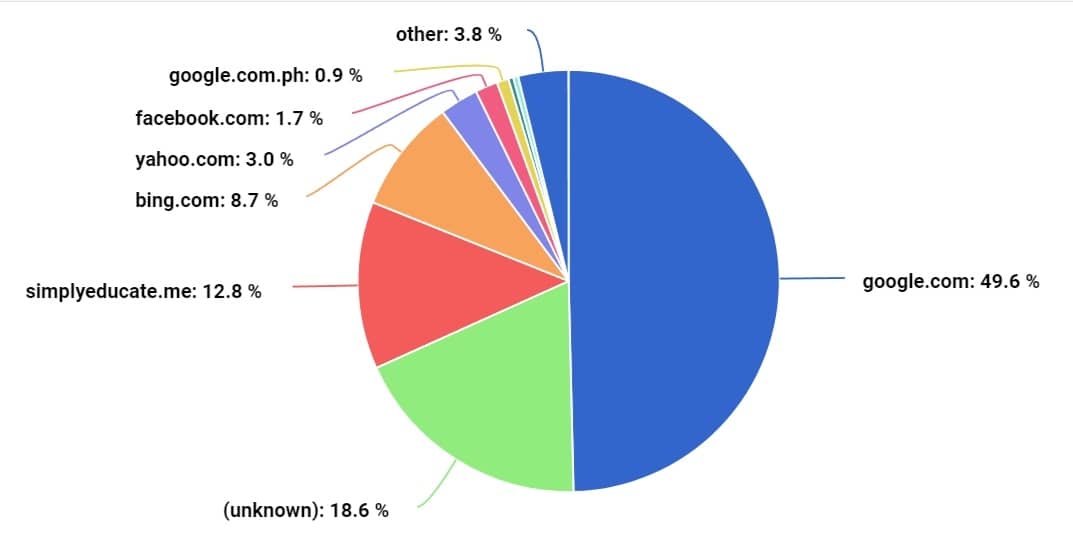
This article will walk you through the process on how to interpret a pie chart. Read on the 7 important steps to follow for better data analysis.
Table of Contents
Introduction
Pie charts are powerful tools in understanding data because of their ability to visually represent proportions and percentages. They provide a clear and concise way to showcase how different categories.
One instance where pie charts are the best graphical option is when analyzing market share. For example, if you want to understand the market share of different smartphone brands, a pie chart can effectively display the percentage of the market held by each brand. This allows you to quickly identify which brands dominate the market and which ones have smaller shares.
Another scenario where pie charts excel is when comparing parts of a whole. Let’s say you want to analyze the distribution of expenses in a household budget. A pie chart can visually represent the percentage of the budget allocated to categories, such as housing, transportation, food, and entertainment. This enables you to easily identify which categories consume the largest portions of the budget.
Read more on managing personal finances: The Importance of Personal Financial Planning: A Comprehensive Guide to Creating and Achieving Your Financial Goals
Pie charts are also useful for showing trends. For instance, if you want to track the sales performance of different products over a period of months, a series of pie charts can illustrate the changes in market share for each product. This allows you to identify any shifts or patterns in consumer preferences.
Pie charts are powerful tools for understanding data because they provide a visual representation of proportions and percentages. They are effective when analyzing market share, comparing parts of a whole, and tracking trends.
How to Interpret a Pie Chart: 7 Key Steps
Interpreting a pie chart may seem straightforward, but it’s important to follow a systematic approach to ensure accurate understanding and analysis. By following these steps, you can effectively interpret a pie chart and gain valuable insights from the data it represents.
Step 1: Examine the title and labels
The first step in interpreting a pie chart is to carefully examine the title and labels. The title summarizes the information being presented, while the labels on the chart show the different categories or components being represented. Understanding the title and labels is crucial as it sets the context for the data and helps you identify what the chart is illustrating.
Step 2: Analyze the proportions
Once you have familiarized yourself with the title and labels, the next step is to analyze the proportions of the pie chart. Each slice of the pie represents a proportion or percentage of the whole. By visually comparing the sizes of the slices, you can determine the relative importance or contribution of each category or component. This step is essential in understanding the distribution or allocation of the data being represented.
Step 3. Identify the largest and smallest slices
After analyzing the proportions, it is important to identify the largest and smallest slices of the pie chart. The largest slice represents the category or component with the highest proportion, while the smallest slice represents the category or component with the lowest proportion. This step helps you identify the dominant and minor categories or components within the data set.
Step 4: Interpret the percentages
Besides analyzing the proportions, it is crucial to interpret the percentages associated with each slice of the pie chart. The percentages provide a quantitative measure of the contribution of each category or component. By understanding the percentages, you can compare the relative importance of different categories or components and make informed decisions based on the data.
Step 5: Consider the context
Interpreting a pie chart goes beyond analyzing the individual slices. It is important to consider the context in which the data is presented. This includes understanding the purpose of the chart, the source of the data, and any relevant background information. By considering the context, you can ensure that your interpretation is accurate and meaningful.
Step 6: Look for patterns or trends
Pie charts can also reveal patterns or trends over time or across different categories. By examining the chart for any noticeable patterns or trends, you can gain insights into the data and identify any significant changes or relationships. This step is important when analyzing data that spans multiple time periods or when comparing different groups or categories.
Step 7: Draw conclusions and make inferences
The last step in interpreting a pie chart is to draw conclusions and make inferences based on the analysis. By considering the proportions, percentages, context, and patterns, you can draw meaningful conclusions about the data and make informed decisions or recommendations. It is important to base your conclusions on the evidence provided by the pie chart and avoid making assumptions or generalizations.
Interpreting a pie chart involves a systematic approach that includes examining the title and labels, analyzing the proportions, identifying the largest and smallest slices, interpreting the percentages, considering the context, looking for patterns or trends, and drawing conclusions.
By following these steps, you can effectively interpret a pie chart and gain valuable insights from the data it represents. Remember to consider the specific context and purpose of the chart to ensure accurate interpretation and analysis.
Example of a Pie Chart and Its Interpretation
Let me illustrate the procedure given in the previous section by giving a pie chart interpretation example, where I highlight the main points. The pie chart I will feature in this example is generated by Ezoic’s big data analytics, which is an important source of information on the management of this website.

Now, let’s look at the web traffic source of this website in January 2024. The pie chart represents the distribution of web traffic across different sources. We can title the chart as Web Traffic Distribution by Source of Simplyeducate.me January 2024.
The chart has 11 slices, each representing a different web source: google, unknown, simplyeducate.me, bing.com, yahoo.com, facebook.com, google.com.ph, three unidentified sources, and other as the last category.
Following the step-by-step procedure in the previous section, the first step in interpreting this pie chart is to examine the title and labels. The title provides an overview of the information being presented, which is the web traffic distribution by source in January 2024.
The labels on the chart show the different web sources as enumerated in the last paragraph. Understanding the title and labels helps us identify what the chart is illustrating, which is the distribution of web traffic across these categories of web sources.
Next, we analyze the proportions of the pie chart. By visually comparing the sizes of the slices, we can determine the relative importance or contribution of each web traffic source.
In this example, we can see that google.com slice occupies 49.6% of the pie, the unknown slice occupies 18.6%, the simplyeducate.me slice occupies 12.8%, the bing.com slice occupies 8.7%, the yahoo.com slice 3%, facebook.com slice 1.7%, and google.com.ph contributes 0.9%.
This analysis allows us to understand the distribution or allocation of web traffic across the different web sources. Although unknown and others occupy a significant part of the pie chart, it is not useful to us. We can leave these web traffic sources in interpreting the pie chart and examine them later for potential significance.
Identifying the largest and smallest slices is the next step. In this example, the google.com slice is the largest, representing the category with the highest proportion of web traffic at almost 50%. The facebook.com and google.com.ph slices are the smallest, representing the category with the lowest proportion of sales. This step helps us identify the dominant and minor categories within the data set.
Interpreting the percentages associated with each slice is crucial. In this example, the percentages provide a quantitative measure of the contribution of each web source to the overall web traffic. By understanding these percentages, we can compare the relative importance of each web source and make informed decisions based on the data.
If we want to make management decisions to improve the web traffic of simplyeducate.me (this website), then it s easy to figure out that there is a need to increase social media exposure (e.g. Facebook.com), besides the organic traffic derived from search engines (e.g. Google, Bing, Yahoo).
Having a significant percentage of the web traffic coming from the site itself (e.g. Simplyeducate.me) means that much of the traffic to the website is coming from internal sources such as links within the website or from users who have bookmarked the website. This type of traffic is known as direct traffic.
Direct traffic is an important metric to track because it can indicate the level of brand awareness and loyalty among users. It could mean that more people are becoming familiar with simplyeducate.me and are returning to the website directly.
Considering the context is also important when interpreting a pie chart. In this example, we need to understand the purpose of the chart, which is to analyze the web traffic distribution by web source for the month of January 2024. We also need to consider the source of the data and any relevant background information. By considering the context, we can ensure that our interpretation is accurate and meaningful.
Last, we can look for patterns or trends in the pie chart. For example, if simplyeducate.me as direct web traffic source has been consistently growing over the years, we can identify a positive trend. If the google.com web source has been decreasing, we can identify a negative trend (This is actually happening). These patterns or trends can provide valuable insights into the data and help me as the site manager to identify any significant changes or relationships and take appropriate, informed action.
The conclusions and sensible actions I could make based on the pie chart analysis are as follows:
- Conclusion: Social media site exposure is minimal.
- Management Action: Increase social media exposure of simplyeducate.me specifically on facebook.com (did that by posting a link to a newly published article and it obtained web traffic).
- Conclusion: Direct traffic significantly accounts for web traffic on the website.
- Management Action: Write more frequently on highly educational articles given that the website is already directly visited and many readers are familiar with it. It is already a brand familiar to many readers.
- Conclusion: Web traffic from Bing.com and Yahoo.com has increased significantly in the last 6 months (line chart interpretation). Both are search engines like Google.
- Management Action: Enhance web traffic from bing.com and yahoo.com which I noticed has increased in the last several months.
Examining the other sources of web traffic by looking at the row of web sources on the accompanying table, I noticed that edu.ph contributes a substantial portion of the web traffic to simplyeducate.me. When I asked Bing Chat about it, the chatbot replied the web traffic shows that simplyeducate.me has become a significant educational resource in the Philippines. edu.ph is a service that provides free and paid registration, modification, and database search for domain names with the .ph extension. It is a top-level domain used by educational institutions in the Philippines to register their domain names.
Conclusion
The previous sections have provided a comprehensive guide on how to interpret a pie chart. By following the steps outlined and analyzing an example of a pie chart, we have learned the key elements to consider when interpreting this type of data visualization.
One key takeaway from this discussion is the importance of understanding the title and labels of the pie chart. These provide crucial information about what the chart represents and the categories being compared. By examining the proportions of the slices and identifying the largest and smallest ones, we can gain insights into the relative importance of each category. Additionally, interpreting the percentages associated with each slice allows us to quantify the contribution of each category to the overall data set.
Considering the context of the pie chart is also essential. Understanding the purpose of the chart and any relevant background information helps ensure accurate interpretation and analysis. Finally, looking for patterns or trends within the chart can provide valuable insights into the data and help identify significant changes or relationships.
In conclusion, interpreting a pie chart involves a systematic approach that includes examining the title and labels, analyzing proportions, identifying the largest and smallest slices, interpreting percentages, considering the context, and looking for patterns or trends. By following these steps, we can effectively interpret pie charts and gain valuable insights from the data they represent.
I hope this article satisfies your search for information on how to interpret a pie chart systematically.


